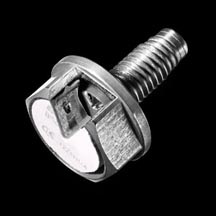General Motors has used RFID tags on engine assembly systems for process tracking for many years. Now GM's Gen 5 Small Block engine program is also using RFID-enabled track-and-trace databolts as a quality control measure during the machining of engine blocks and cylinder heads.
There are 29 machining processes for Gen 5 blocks and 11 machining processes for Gen 5 heads. Databolts are installed on each block and head at the beginning to help ensure that no processes are missed. At the end of machining, the databolt travels with the part to the assembly line where the block and head are assembled into an engine. The bolt can reliably identify the exact time and place a block or head goes through each process. The device is shaped like a regular bolt, but the head is hollow. Inside, secured with epoxy, are a RFID chip and a coiled metal filament antenna.

Image source: PopularMechanics.com
The databolts are scanned at the end of machining line to confirm successful completion of all processes. They also help confirm that each engine block is leak-free when tested. If a flaw is discovered on a block or head, its databolt enables identification of the blocks and heads made before and after the part for further inspection. This allows line operators to determine if the issue was an anomaly or a larger problem. This measure also helps ensure that no defective parts leave the plant. At end of the assembly line the databolt is removed, and reused.
Each databolt holds 2048 bytes, relatively little data by general computer standards, but more than enough to track information of each process. GM also uses a parallel IT Quality system called Flexnet where the information from databolts is transferred and stored for future reference.
Advertisement
Learn more about Electronic Products Magazine





